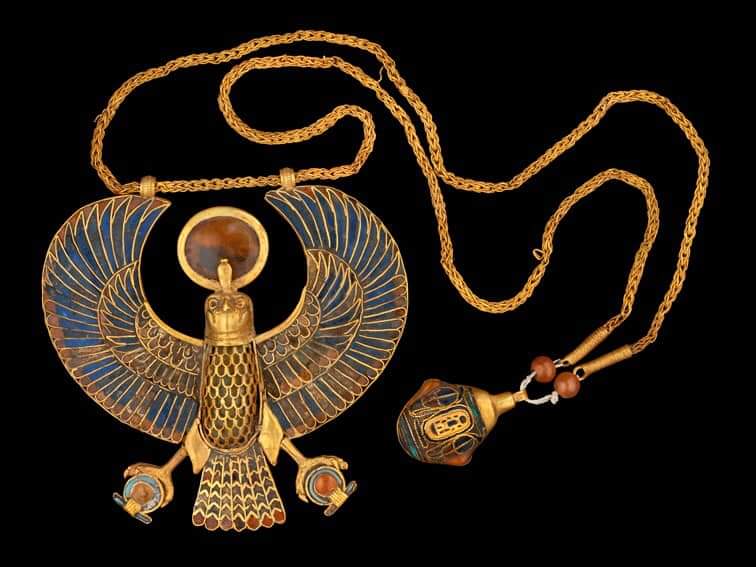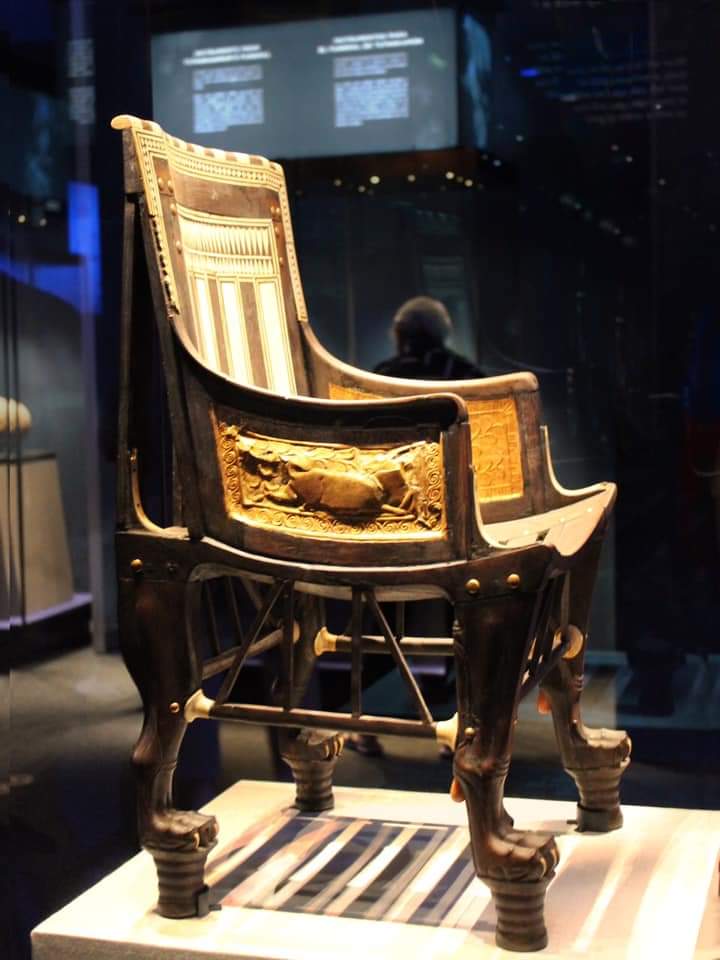CAIRO - 28 August 2020: “Tutankhamun: Treasures of the Golden Pharaoh” exhibition returned back to Egypt from London on Friday, August 28.

The exhibition was closed in London in March, 44 days before it was planned to end because of the outbreak of the coronavirus pandemic.

Despite the fact that the Egyptian government has approved compensation for the exhibition’s organisers for the closure period and to extend the display period of the exhibition to July and August, the precautionary measures of coronavirus in London made it hard to extend the exhibition.

Mostafa Waziri, secretary general of the Supreme Council of Antiquities (SCA), the board of directors of the SCA decided to choose 20 artifacts out of the 166 items that were displayed in the exhibition to be exhibited temporarily in Hurghada and Sharm El-Sheikh museums before being transported to their permanent display at the Grand Egyptian Museum, which is planned to open in 2021.
This decision came to promote both museums and cities.
Moamen Othman, head of the ministry’s Museum Sector announced that statue of Ka, the consort of King Tutankhamun, will be the displayed at Sharm El-Sheikh Museum and the gilded wooden statue of god Ptah will be the displayed at Hurghada Museum.
Hurghada Museum has recently opened and Sharm El-Sheikh Museum is set to be opened this year.
The first stage of Tutankhamun exhibition was in California Science Center.
Artifacts from King Tutankhamun’s tomb have been shown at an exhibit since March 24, 2018. The exhibit’s date has coincided with the 100th anniversary of the discovery of King Tutankhamun’s tomb.
The most famous ancient Egyptian king’s tomb was discovered in 1922; more than 3,000 years after his death.
The collection exhibited at the California Science Center was the biggest collection of artifacts from King Tutankhamun’s tomb to be shown outside of Egypt.
Ministry of Tourism and Antiquities announced that the revenues of the temporary exhibition “King Tut: Treasures of the Golden Pharaoh” which was launched in California Science Center on March 23, 2018 amounted to $5 million.
The exhibition was visited by about 700,000 visitors, and the ministry took $4 for each ticket.
The temporary exhibition “King Tut: Treasures of the Golden Pharaoh” was then moved from the California Science Center to grand Lafayette Hall in Paris, France, from March 18, 2019, to Sept. 30, 2019.
This move aimed to promote the cultural ties between Egypt and the world, while also boosted international tourism in Egypt.
The French and international news outlets reported that the temporary exhibition of King Tutankhamun that was display at the Grande Halle La Villette in Paris broke records of turnout of the French cultural exhibitions.
The exhibition "Tutankhamun: The Treasures of the Golden Pharaoh" came to an end in Paris on the evening of Sept. 22, breaking the record in the history of cultural exhibitions in France.
The exhibition was visited by 1,423,170 visitors in the past six months since it was opened by the Minister of Antiquities on March 23, 2019 at the Grand Hall de la Villette.
International media outlets stated that the exhibition is the most visited exhibition in France.
The French and international newspapers pointed out that this exhibition and other temporary foreign exhibitions held by Egypt abroad are the best publicity for Egypt and its ancient civilization and unique treasures, which will have a positive impact on tourism in Egypt.
The Minister of Antiquities explained that in 1967, when France hosted the Tutankhamun exhibition for the first time, it attracted 1,240,975 visitors.
Today, 52 years later, the Golden King's exhibition attracted more than 1.4 million visitors, which indicates how passionate the French people and visitors of France are towards the ancient Egyptian civilization.
In addition, Anani stated that despite the success of the exhibitions, they allowed the French people and visitors of France to see only a small and simple portion of the treasures of the Golden King and the ancient civilization of Egypt.
The Minister of Antiquities affirmed that this exhibition is an invitation to attract and encourage millions of enthusiastic visitors to Egypt, to see and enjoy its great and unique civilization, discovering thousands of pieces of the treasures of the Golden King and to visit and enjoy watching many archaeological areas and distinctive museums throughout Egypt.
The exhibition moved to the British capital, London, in November 1, in its third stop.
The temporary exhibition of King Tutankhamun entitled "Tutankhamun ... Treasures of the Golden Pharaoh" will return back from London to Egypt after two or three days maximum.
It is worth mentioning that the exhibition "Tutankhamun: The treasures of the Golden Pharaoh" included 150 artifacts from the collections of the young king, including a number of gilt ushabti statues, wooden boxes, canopic pots, a gilded wooden Ka statue and alabaster pots.
"Tutankhamun ... Treasures of the Golden Pharaoh" exhibition was launched by Egyptian Minister of Antiquities Khaled al-Anani and the French minister of culture in March 2019 and continued until September 22.
Acclaimed archaeologist Zahi Hawass has finished the script for Tutankhamun Opera, set to debut in the opening ceremony of the Grand Egyptian Museum in 2021.
Hawass announced that one of the most important scenes in Tutankhamun Opera revolves around Nefertiti's attempt to kill Tutankhamun and snatch the throne for one of her six daughters.
Composed by Zamboni, the opera's score will be completed this December, according to Hawass.
Hawass previously added that November 4, 2022 will be the centenary of the discovery of Tutankhamun tomb, who is an important king to the whole world not Egypt only.
Hawass stated that the DNA tests will reveal a lot of information about the death of Tutankhamun and that he will announce to the whole world in 2020 how the golden king died.
Hawass previously said in an interview with Italia 1 Channel that the temporary exhibition of King Tutankhamun currently that was displayed at the Grande Halle La Villette in Paris broke the records of turnout of the French cultural exhibitions.
It is the most visited exhibition in France, where the total number of registered visitors so far has reached 1.5 million, as recounted by Hawass.
In his interview with the Italian channel, Hawass revealed a number of important facts about the family of the Golden Pharaoh, announcing that his father is King Akhenaten and that the mummy of his mother is located at tomb number 35 where the grandmother of Tutankhamun, Tiye, was buried.
Hawass added that Tutankhamun was suffering from lack of blood reaching the feet, flatfoot and malaria.
Tutankhamun was born in the 18th Dynasty, around 1341 B.C., and was the 12th pharaoh of that period.
Tutankhamun did not accomplish much himself; he was placed on the throne when he was a child, and Egypt’s prosperous era was beginning to decline with the rise of Pharaoh Akhenaten and his new cult.
Sir Howard Carter, British archaeologist and Egyptologist, had made it his life’s quest to find the tomb of King Tutankhamun.
When Carter had begun to work in Egypt in 1891, most of the documented Pharaohs had their tombs discovered. One, however, proved to be elusive; King Tutankhamun, whose resting place had yet to be found and who Egyptologists knew very little about.
With the end of World War I, Carter made it his goal to be the first to uncover the tomb of Tutankhamun. Carter had worked in Egypt for 31 years since he was 17, using his skills as an artist to copy inscriptions from walls.
He would then become appointed inspector-general of monuments in Upper Egypt. In 1907, he started to work for George Herbert, the fifth earl of Carnarvon, who would aid him in his quest to uncover the lost tomb of Tutankhamun.
Carter was certainly dedicated, spending massive amounts of money and time in order to track down where the tomb might lie.
With Lord Carnarvon as his sponsor, he began working earnestly at excavating the Valley of Kings. Alas, even after five years of work, Carter wasn’t able to report back on anything substantial.
He refused to give up however, tirelessly working to fulfil his quest, and soon enough, Carter would be rewarded beyond his imagination.
The discovery of steps beneath the sand on November 1, 1922 was a breakthrough for Carter. At long last, his tireless search for Tutankhamun would finally bear fruit.
Carter announced the discovery on November 6, and it took three weeks until he could begin work on excavating into the tomb.
Workers exposed all of the steps and the sealed doorway into the tomb, which at one point had been broken in by tomb robbers but resealed again, leading to hope that the contents had not been plundered.
Carter finally entered on November 25, finding evidence of resealed holes but noting that it had likely been thousands of years since anyone had entered again.
When Carter made a hole inside the sealed door and peeked inside, he was left astounded. Gold flooded his senses, and animal statues, rich perfumes, piles of ebony, childhood toys and the Pharaoh himself adorned the room alongside countless other treasures.
It was a bounty of riches the likes of which had never been seen before. Carter couldn’t have anticipated this finding in his wildest dreams.
Comments
Leave a Comment